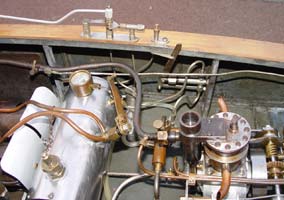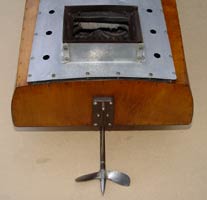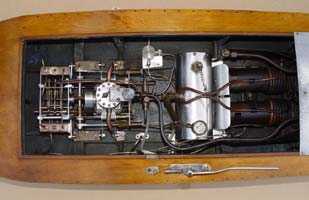

|
Home Updates Hydros Cars Engines Contacts Links Contact On The Wire |
Still, ‘ITSA’ Mystery
|
A few months ago, we featured a ‘mystery’ flash steam hydroplane in Pitbox called ‘ITSA’. In spite of publicising it on the site and asking everyone involved that might be able to help, there was still no idea who had built it or when. There were a few clues, but it is was mainly guesswork as there is no club or registration number to head us in the right direction. Its history is known since the mid 1980s when it was featured in Model Boats, having been retrieved by Malcolm Beak of the St Albans club. Malcolm recalls " I can't remember exactly when I brought it - probably around 15 years ago from someone in Woodbrige (Suffolk). As I remember it, he was an architect and had obtained ITSA from a junk shop in the Ipswich area with the intention of using it when 'furnishing' properties for sale. It came to me as it is now, with no propeller and a bent drive shaft". |
|
Malcolm provided the following thoughts about ITSA. "A 'Kipper Box' flash steam hydroplane, probably from the 1930s. At that time, the single point tether was used and the boats ran in a clockwise direction (viewed from above). The multi-point tether and anticlockwise running was introduced soon after WW2. I don't think ITSA was used much in anger as there is only one tether point, and practically all hydro's from that era show evidence of having been tried out with several attachment points until the best had been found. I have had the engine out and it runs strongly on compressed air. While it was out, I started the blow-lamp for a few seconds and then discovered that the boiler coils had been filled with oil! I can't help feeling that ITSA had been put to bed and her owner had gone off to war and never came back."
The boat remained with Malcolm until recently, when it passed to Peter Hill and the chance came to photograph it for OTW. In June this year, the decision was made to renovate it, and as the engineering involved in the boat and steam plant was of such a high quality, the process was recorded by OTW in order to show the complexity of one of these fearsome beasts. Although the 'bent shaft' had been straightened, it was necessary to find a suitable prop, and those for flash steamers tend to be very large. Luckily, Peter Hill's spares box provided something of the correct vintage and size that just needed bushing to complete the restoration of this impressive hydroplane.
The amount of ‘plumbing’ in the boat beggars belief, so the first job was to try and understand where all the pipes went and what everything was for. After several days of pondering, it was decided to strip the entire plant out of the hull and assess the condition from there. With every pipe being labelled as it came out, there was soon a very large pile of bits and a very dirty motor.
|
The general condition of the hull was superb and nothing more than a clean and polish was required. All the pipe work and accessories were nickel plated, which would be unusual today, but was quite common both on models and in full size practice for many years. The hull is exceptionally well built and mirrors many of the flash steam hydros around in the immediate post war period, single step, submerged prop and a metre long. What is apparent is the planning that went into the construction as the engine bolts and fittings were put in before the skinning of the hull. |
|
|
|
The motor was nothing short of filthy with congealed steam oil and lubricating oil liberally coating everything. Several applications of Auto Glym Motor Cycle Cleaner soon had it sparkling and revealing the true level of the engineering that had been incorporated in this engine. Left: The 'goo' that came off the motor, ten pence for comparison of the heap |
|
Because of the quality of the plant, it was decided to go one stage further and assemble it all outside the boat so all the elements could be seen and described. |
|
|
|
The heart of a flash steamer is the steam generator/boiler and the major change was going to primus type nipples and venturis rather than the conventional paraffin blowlamps, which can help date ITSA. It also has a conventional fuel tank pressurised by a bicycle pump, rather than a fuel pump driven off the engine, and this does reduce the length of time the plant can run at one go. |
|
The motor is a relatively standard single cylinder unit with piston valve admission for the steam and uniflow exhaust. This has the exhaust ports towards the bottom of the cylinder, which are uncovered at the bottom of the stroke. What is unusual about this engine are the external balance weights for the piston valve and the lubrication arrangements. |
|
|
|
Because flash steamers run at steam pressure into the thousands of psi and several hundred degrees temperature, a displacement lubricator normally pumps oil directly into the steam line or valve chest. This engine relies on oil from one of three mechanical pumps. These are on the rear of the engine and driven from the crank by two sets of worm gears. Two of the eccentric driven plunger pump oil to the main bearings, while the third puts oil into the steam line, hence the two oil tanks, one for steam oil, one for lubricating oil. |
|
Water is pumped into the steam coil by two pumps that use the same shafts as the oil pumps, but only one set of reduction gears. A screw bypass valve controls the amount of water going to the coil. Water is picked up under the step into a filtered reservoir, again with a bypass to ensure continuous supply. It was here that a problem was discovered; as the water bypass was not connected to anywhere so would end up sinking the boat. This did cause a bit of head scratching until a blanked off hole was found on the back of the water reservoir, which was soon replaced with a screwed piece of pipe to connect to the bypass. The search is on though for some suitable rubber pipe to replace the silicone fuel tube currently being used. |
|
|
|
Strangely, there is a displacement lubricator, but this supplies oil to the drive shaft bearings and by a cunning arrangement, through the skeg and into the prop shaft bearings. The other items are a hand water-priming pump for getting up steam pressure and a very complicated ‘knock off’ that vents the pressure from the fuel tank and bypasses the water supply to the steam coil at the same time. Incorporated into this unit also is a ‘tell tale’ outlet from the water reservoir to show that water is going to the coil throughout the run. |
From the above, the style of the hull and the single tether point, ITSA would seem to be at least 60 years old, if not a little more. Perhaps this might jog a memory or uncover a reference that could identify who was responsible for the superb engineering in this fine flash steam hydroplane.
 |
 |
 |
| Knock-off, priming pump, fuel valve, bypass | Oil pumped through skeg | All the 'works' in situ |
In the months since this article was written, the detective work to try and discover who built the boat has continued. Jim Free remembered its earlier appearance in Model Boats and thought it might have been a Blackheath boat, which led to a conversation with John Benson who believed this might be the case and suggested that it could have been built by a Mr Clay, who was a member and a fine engineer as well. John also remembered that the boat was never run, which would fit in with the evidence so far. Discussion with the current Blackheath secretary, Phil Abbot led to the name of Alf Clay. Although he did become a member of Blackheath in the late 50s running steam powered straight runners, it is probably that he was originally a member of the Orpington Club, as he lived in the New Eltham area. This would tie in with George Lines, also of the Orpington Club, who built a series of flash steamers from the late 30s through to the early 50s. His boats were named Blitz and showed very similar design features to those found in ITSA. Orpington, Blitz, ITSA, George Lines, Alf Clay. Is there a connection? Research continues.
Thanks to Malcolm Beak, Peter Hill, John Benson, Phil Abbot and Jim Free for help in telling (most of) the story of ITSA
©copyrightOTW2009.